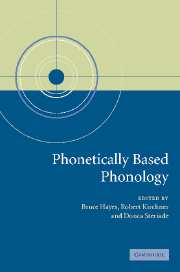Book contents
- Frontmatter
- Contents
- List of contributors
- List of abbreviations
- 1 Introduction: the phonetic bases of phonological Markedness
- 2 A review of perceptual cues and cue robustness
- 3 Place assimilation
- 4 The typology of rounding harmony
- 5 The evolution of metathesis
- 6 The role of contrast-specific and language-specific phonetics in contour tone distribution
- 7 Vowel reduction
- 8 Contrast and perceptual distinctiveness
- 9 Syllable weight
- 10 Consonant lenition
- 11 Language processing and segmental OCP effects
- Index
11 - Language processing and segmental OCP effects
Published online by Cambridge University Press: 21 October 2009
- Frontmatter
- Contents
- List of contributors
- List of abbreviations
- 1 Introduction: the phonetic bases of phonological Markedness
- 2 A review of perceptual cues and cue robustness
- 3 Place assimilation
- 4 The typology of rounding harmony
- 5 The evolution of metathesis
- 6 The role of contrast-specific and language-specific phonetics in contour tone distribution
- 7 Vowel reduction
- 8 Contrast and perceptual distinctiveness
- 9 Syllable weight
- 10 Consonant lenition
- 11 Language processing and segmental OCP effects
- Index
Summary
Introduction
The Arabic verbal roots are subject to a long-distance phonotactic constraint that is well known for its implications for autosegmental representation (McCarthy 1986, 1988, 1994). In this constraint, originally proposed as an instantiation of the Obligatory Contour Principle (Goldsmith 1979), repeated place of articulation features are not allowed within a root. Subsequent research has shown that the details of consonant occurrence in the Arabic roots are complex, with the strength of the phonotactic restriction gradiently dependent on the similarity of the consonants involved, the presence of intervening segments, and the contrasts available in the segmental inventory of Arabic (Pierrehumbert 1993; Frisch, Pierrehumbert, and Broe 2004).
The gradience of the phonotactic patterns in the Arabic lexicon provide strong evidence for a functional phonetic motivation for the constraint. The similarity avoidance constraint in Arabic is quantitatively dependent on similarity, distance between segments, segment frequency, and segmental position in the word. No formal model that prohibits feature co-occurrence like the autosegmental OCP can capture the richness of the patterning. However, a wide range of evidence from psycholinguistics suggests that processing a sequence of similar items is more difficult than processing a sequence of dissimilar items. Thus, we can account for the presence of similarity avoidance constraints in the phonotactics of Arabic as a consequence of functional pressure to make language processing as easy as possible. I claim that the richness of phonotactic patterns directly (quantitatively) reflects the functional explanation. In this way, statistical analysis of the lexicon provides a novel type of evidence for functionally motivated constraints and rules out alternative formal explanations (see Hawkins 1994 for similar arguments at the syntactic level).
Information
- Type
- Chapter
- Information
- Phonetically Based Phonology , pp. 346 - 371Publisher: Cambridge University PressPrint publication year: 2004
Accessibility standard: Unknown
- 20
- Cited by
